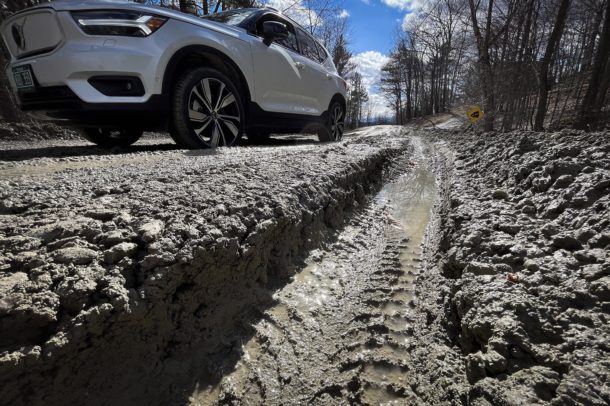Gravel Slalom and Roads Scholarship

A driver navigates ruts on Texas Hill Road in Hinesburg March 21, 2022. Photo by Glenn Russell/VTDigger
It’s only January and the annual back-roads slalom season has begun – where even the most abstemious seem to be driving under the influence. Some experienced back-roads slalom drivers appear like recent arrivals from England or Australia, driving freely on the left except as they approach the brow of a hill.
It’s an annual rite and, with all the untimely thawing and rain, many of Vermont’s dirt byways have become deeply pocked, chiropractic wash-board roads or porridge-like slurries of mud, or both.
It’s assumed that sober folks driving on paved roads steer along the roads’ lanes and only drunks or drivers texting or checking emails zig-zag. But on our gravel roads the opposite is true. Intoxicated drivers tend to try and drive straight down the middle while sober drivers zig-zag to avoid potholes and sinkholes.
The most worrisome section of our own Baldwin Road runs by a small 19th century graveyard, and many of us in the ‘hood quail at the thought of what seeps out into the road we travel daily.
The few imported Yugos, Ladas, and Renaults as well as our domestic Rambler American rust-buckets that made it to Vermont in my early days rarely lasted a year on Vermont’s secondary roads. One Yugo was found buried deep in mud on a road in Eden when a trout fisherman spotted a side-view mirror sticking out of the ditch on the side of the road.
Renault Dauphines typically rusted out in 18 months and became very popular as composters. Gardeners pitched food and garden scraps in through the open sunroof and, after a few months, opened the doors and harvested rich loam.
I’ve finally reached that mind-body equilibrium we all seek. I’m both a “Roads Scholar” and a Gravel-Road Slalom competitor. You’re probably not familiar with either unless you live year-round at the end of a four-mile long dirt road followed by a steep driveway with switchbacks.
During a spring ice storm, learning to manage a controlled backwards skid is critical on our driveway when the wheels are turning in forward gear but the car is moving backwards.
And don’t try what I once did, even though I survived: Once, when my VW Bug was simply spinning on a steep hill coated with black ice and not moving at all, I got out, leaving it in gear, and tried to push it with no one inside. It worked… once.
Navigating our frozen driveway also reminds me of when I was teaching my youngest son to ski at Cochran’s. I was skiing down the practice slope in a backwards snowplow while bending forward to keep my youngster’s ski tips together as I taught him how to snowplow. Hard to believe, but with practice, there is such thing as a controlled skid, even going backwards (be sure to adjust your rearview mirror).
For many the primal angst of “mud season” was diminished somewhat with the invention of Tyvek, now underlying the uppermost gravel layer on some of Vermont’s back roads. The deep mires of spring mud that gave birth to the name “mud season” and “Mud City” and have been a defining spring characteristic since Vermont was a feisty Republic, have been reduced thanks to the miracle of Tyvek. It functions like a check valve in plumbing by allowing rainwater to seep down while preventing ground water from rising and brewing mud.
Old dirt roads are scarified and a subdermal layer of heavy Tyvek is laid down on the old gravel and then covered with another layer. This reduces the up-flow of groundwater. This same decorative lingerie gracing many unfinished homes in our backwoods turned out also to be a boon for those of us living on back roads where, in spring, the groundwater bubbles up over the road surface.
As to Roads Scholarship, visitors driving along our back-country roads after a few days of inclement weather may be surprised to see locals slaloming along the full width of our two-lane roads even as they approach hilltops. Unless you’re born to the sport of gravel-road slalom, it will seem odd at first, if not fatal.
It’s a thrill to follow an expert back-road slalom driver in the spring as they bob and weave back and forth across the full width of the visible road. They instinctively know their wheelbase and can usually find parallel passages through a serious cluster of potholes, keeping both tires on a flat track or at least avoiding the deepest holes. Water-filled holes are the most deceptive as one can’t assess their true depth.
Gravel-road slalom lacks the grace of a great snow skier following the fall line through a tight web of fiberglass poles throwing up clouds of snow from side to side. The gravel moguls we toss up on the roadbed as we carve our way through the aggregate only makes matters worse for the next driver. After several broken tie-rods and a blown shock or two, you’ll learn to appreciate this unique Yankee sport.
And, if you see a hand-painted roadside notice offering to buy recyclable metal, look ahead for a whopper pothole. Tie rods, blown shocks, hubcaps, bent wheel hubs, even the occasional ancient Renault rusting in a nearby field should serve as a warning, and by the way, if you imagine that speeding over a pot-hole will incur less damage, you’re in for a costly surprise.
Newcomers are often deceived by the idea that driving at very high speed means the wheels don’t have time to actually penetrate potholes. They learn fast when a costly MacPherson strut rockets through the leather upholstery in the rear seat. Driving on washboard is like skiing on ice. There’s little one can do but slow down, if possible, and go straight over it.
In the good old days, cars sank in well over their running boards and draft horses strained as if they were at the county fair horse pulls to overcome the mud’s suction. Those days are gone. To avoid the mires today, most cars simply take an alternate route.
Although, several years back, I remember on Monkton’s Prison Hollow Road seeing a D4 Caterpillar dozer that had tried to extract a large John Deere tractor from a mud bog on a side road. Both were above their axles in mud and there was no one in sight.
Many suburban Vermonters living in housing developments today that were cornfields fifty years back rarely have to travel dirt roads at all. While the farmers who tilled those fields in the spring had to use flotation tires, the current residents travel only on well-drained aggregate covered with asphalt.
Any seasoned Vermont driver keeps a come-along and log chain in the trunk of their vehicle. A sturdy tree and these two tools connecting the car’s frame and the tree will usually enable an embogged driver to extract their vehicle from anything. Just don’t make the mistake that city folk often make by connecting the chain’s hook to the bumper or the doorknob.
At my age, I’m proud of my Roads Scholarship and my skill at Gravel-Road Slaloming, skills to which most newcomers can only aspire.

